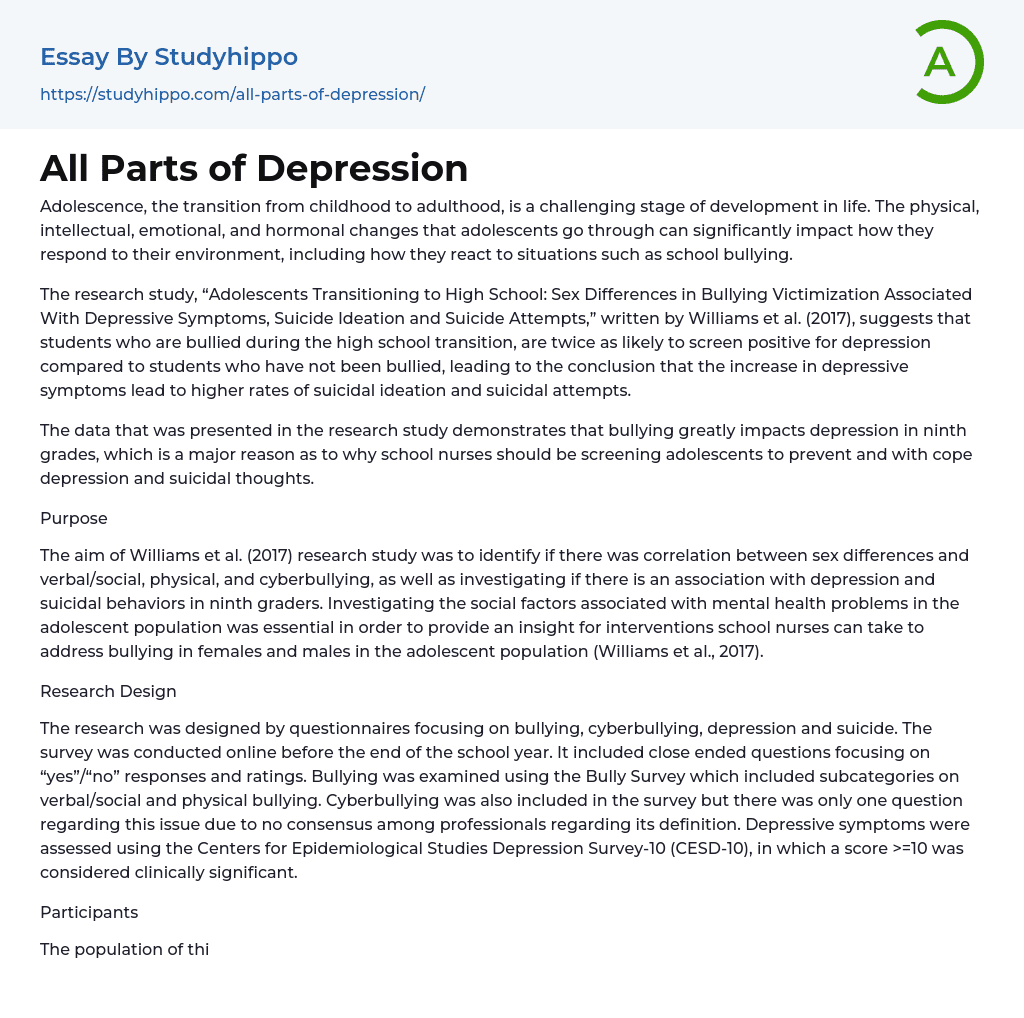Adolescence, which involves the transition from childhood to adulthood, is a challenging phase in life.
The study conducted by Williams et al. (2017) emphasizes the effect of physical, intellectual, emotional, and hormonal changes on how adolescents respond to their environment, including bullying in school. According to the research findings, students who are bullied during the transition to high school are twice as likely to exhibit signs of depression compared to those who have not experienced bullying. This increase in depressive symptoms is linked to a higher incidence of suicidal thoughts and attempts. The study highlights the significant impact of bullying on depression among ninth grade students and underscores the importance for school nurses to assess adolescents in order to prevent and address depression and suicidal thoughts.
Purpose
The purpose of Williams et al.'s study was...
The 2017 research study aimed to investiga
...te the correlation between different types of bullying (verbal/social, physical, and cyberbullying) and sex differences. It also sought to examine if these forms of bullying were associated with depression and suicidal behaviors in ninth graders. The objective was to gain insight into social factors related to mental health problems in adolescents so that school nurses could implement interventions addressing bullying among male and female students (Williams et al., 2017).
To gather data on bullying, cyberbullying, depression, and suicide, questionnaires were used in this research. The survey was conducted online before the end of the academic year. It consisted of closed-ended questions with "yes" or "no" responses as well as rating scales. To assess bullying behavior specifically, the researchers utilized the Bully Survey which included subcategories focusing on verbal/social and physical bullying.
The survey focused on one question about cyberbullying, a
professionals do not agree on its definition. Depressive symptoms were assessed using the CESD-10 scale, with a score of 10 or higher indicating clinical significance.
Participants
A total of 223 ninth-grade students from a suburban high school took part in the study. The participants comprised of 106 males and 127 females. Students in grades 10-12 were excluded from the survey, which specifically targeted those transitioning to the next grade level.
The majority of participants identified themselves as White, with 94% reporting English as their primary language spoken at home. 58% of students reported their family income qualifying for free/reduced price lunches (Williams et al., 2017). Ninth-grade students were given the opportunity to participate in the study by completing an online survey at school. They were also given the option to skip any questions they felt uncomfortable answering.
Based on the collected surveys, it was discovered that students who undergo bullying are twice as likely to display indications of depression.
According to survey data analysis, verbal and social bullying emerged as the most prevalent forms of bullying. The findings indicated that around 60% of ninth-grade students were victims of bullying, while cyberbullying affected approximately 13.7% (Williams et al., 2017). Furthermore, the study revealed a gender disparity in bullying experiences, with a higher percentage of females (78%) reporting being bullied compared to males (50%) (Williams et al., 2017). Moreover, the results from the CESD-10 depression scale demonstrated that 42% of students exhibited significant depressive symptoms. Within this specific group, 10% had not encountered bullying, whereas 32% reported being bullied (Williams et al., 2017).
According to research conducted by Williams et al. (2017), a study discovered that 18 ninth graders had a history of
suicide attempts, all of whom were victims of verbal or social bullying. In addition, females who experienced cyberbullying exhibited high rates of depressive symptoms, suicidal ideation, and suicide attempts.
Limitations
The study's findings were influenced by several limitations. Firstly, it solely focused on ninth graders transitioning into high school and did not include new upperclassmen in the same environment. Moreover, the data was exclusively collected from one school, which limits its generalizability (Williams et al., 2017).
The study had limitations in its narrow focus on bullying and its connection to depression, disregarding other potential causes of adolescent depression. Moreover, the study failed to take into account gender identities when generalizing students as females and males. Additionally, the population studied lacked diversity.
Conclusion
Based on the data collected, it can be concluded that all forms of bullying (verbal, physical, social, and cyberbullying) have long-lasting effects on adolescents. Bullying can lead to depression and increase the likelihood of suicidal behavior among ninth graders. The significance of this data emphasizes the vital role school nurses and counselors play in the school environment.
Nurses can support young adolescents in their transition to high school in order to prevent depressive symptoms. The focus on freshmen students attending their first year of high school gives school nurses insight that can aid in addressing potential issues.
- Adhd essays
- Antisocial Personality Disorder essays
- Anxiety essays
- Bipolar Disorder essays
- Depression essays
- Depression And Anxiety essays
- Dyslexia essays
- Learning Disability essays
- Major Depressive Disorder essays
- Mental Disorder essays
- Mental Illness essays
- Psychosis essays
- Schizophrenia essays
- Stress essays
- Suicide essays




